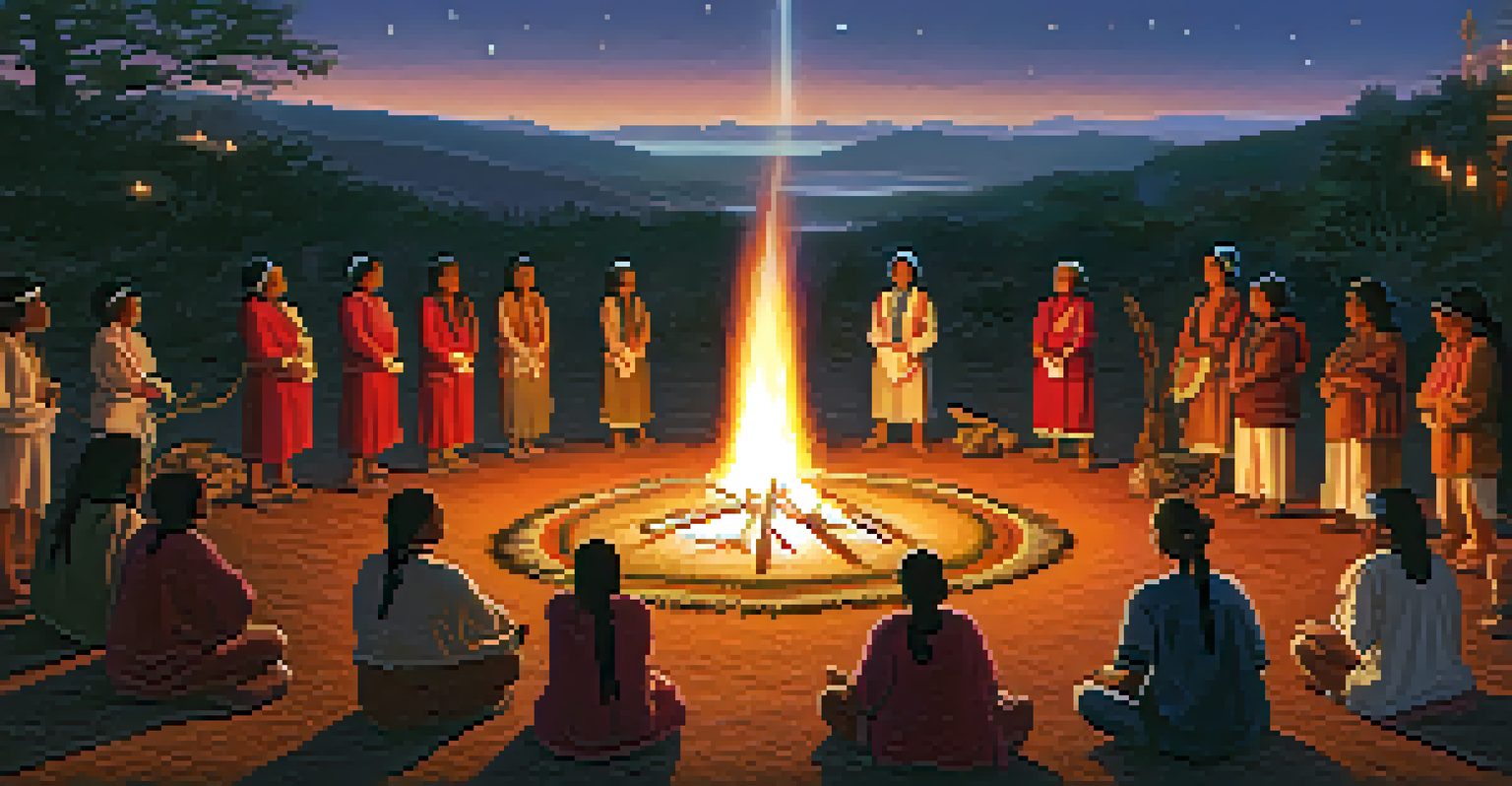Sacred Plants: Indigenous Views on Hallucinogenic Substances

Understanding Sacred Plants in Indigenous Cultures
Sacred plants hold significant spiritual and cultural meanings in many Indigenous cultures. They are often viewed as gifts from the earth, providing not only sustenance but also a connection to the spiritual world. These plants are integrated into rituals and ceremonies, symbolizing the bond between nature and human existence.
Nature is not a place to visit. It is home.
For Indigenous peoples, the use of these plants goes beyond mere consumption; it's about fostering a relationship with nature and the divine. Each plant is imbued with stories and teachings, passed down through generations, that guide individuals in their spiritual journeys. This relationship emphasizes respect, reciprocity, and a deep understanding of the environment.
Hallucinogenic substances derived from these sacred plants are often used in controlled, ceremonial contexts. The experiences they provide are seen as pathways to insight, healing, and connection with ancestors. Thus, the significance of these plants is woven into the very fabric of Indigenous identity and spirituality.
The Role of Hallucinogens in Indigenous Rituals
Hallucinogens like peyote, ayahuasca, and psilocybin mushrooms are central to many Indigenous rituals. These substances are not taken lightly; they are used in guided settings where trained leaders help participants navigate their experiences. This ensures that the journey is meaningful and transformative, rather than chaotic or dangerous.

In these rituals, participants often seek answers to profound questions or healing from trauma. For example, ayahuasca ceremonies in the Amazon are known for their purging effects, both physically and spiritually, leading individuals to confront their inner struggles. The collective experience fosters community bonds and shared understanding.
Sacred Plants as Spiritual Guides
Sacred plants are integral to Indigenous cultures, serving as spiritual guides that foster a deep connection with nature and the divine.
Moreover, these rituals are steeped in tradition, often involving songs, prayers, and specific practices that enhance the experience. This cultural context is vital, as it imbues the use of hallucinogens with purpose and significance, distinguishing it from recreational use commonly seen in modern society.
The Spiritual Connection with Nature
For many Indigenous cultures, the spiritual connection to nature is paramount. Sacred plants are viewed as teachers that offer wisdom and guidance, emphasizing the importance of living in harmony with the environment. This perspective fosters a deep respect for all forms of life, promoting sustainable practices that honor the earth.
Indigenous people have a sacred relationship with the land and all living things. They understand that everything is interconnected.
The use of hallucinogenic substances is often accompanied by rituals that celebrate this connection. Participants may express gratitude to the plants and the earth for their gifts, reinforcing the idea that humans are stewards of the land. This relationship transcends mere exploitation, focusing instead on coexistence and reverence.
Through these practices, Indigenous peoples cultivate a holistic worldview that sees humans as part of a larger ecosystem. This perspective contrasts sharply with exploitative approaches to nature, highlighting the need for balance and respect in our interactions with the environment.
Cultural Misunderstandings and Appropriation
As interest in hallucinogenic substances grows in mainstream culture, misunderstandings and cultural appropriation often arise. Many non-Indigenous individuals seek to use these sacred plants without understanding their significance or the cultural contexts surrounding them. This can lead to a commodification of practices that are deeply rooted in Indigenous spirituality.
Indigenous communities often express concern over the exploitation of their cultural practices by outsiders. When sacred rituals are stripped of their meaning and commercialized, it undermines the spiritual and communal aspects that are vital to their use. This highlights the importance of approaching these practices with respect and humility.
Cultural Appropriation Issues
The growing interest in hallucinogens often leads to cultural appropriation, as many seek to use these sacred plants without understanding their significance.
It is essential for non-Indigenous individuals to educate themselves about the significance of these plants and the cultures that revere them. Engaging with Indigenous voices and supporting their rights to practice their traditions is crucial in fostering understanding and respect.
Modern Science and Indigenous Wisdom
In recent years, there has been a growing interest in the scientific study of hallucinogenic substances. Researchers are exploring their potential therapeutic benefits, particularly in treating mental health issues. However, this scientific approach often overlooks the rich cultural knowledge that Indigenous peoples have regarding these plants.
Indigenous wisdom encompasses centuries of experience and understanding of the effects of these substances, including their potential risks and benefits. This knowledge is invaluable, as it provides insights into safe practices and the spiritual dimensions of use that science alone cannot capture. Collaborating with Indigenous communities can enhance research efforts and ensure ethical practices.
The intersection of modern science and Indigenous wisdom presents an opportunity for mutual learning. By respecting and integrating Indigenous knowledge, researchers can develop more holistic approaches to understanding and utilizing these sacred plants.
The Healing Power of Sacred Plants
Many Indigenous cultures recognize the healing power of sacred plants, both physically and spiritually. Hallucinogens are often used in therapeutic settings to address various ailments, including mental health disorders and emotional trauma. This holistic approach to healing emphasizes the interconnectedness of mind, body, and spirit.
For example, the use of peyote in Native American Church ceremonies is not only about the hallucinogenic experience but also about creating a supportive community for healing. Participants come together to share their stories, fostering a sense of belonging and understanding. This communal aspect enhances the healing process, as individuals feel supported in their journeys.
Healing Through Community Rituals
Indigenous cultures harness the healing power of sacred plants in communal rituals, addressing both individual and collective traumas.
The healing potential of these plants extends beyond individual experiences; it can also contribute to community resilience. By addressing collective trauma and fostering connections, Indigenous communities can heal from historical wounds and strengthen their cultural identity.
Respecting Indigenous Rights and Practices
As the conversation around sacred plants and hallucinogens continues to evolve, it is essential to respect Indigenous rights and practices. This includes recognizing their sovereignty over traditional knowledge and practices related to these plants. Supporting Indigenous-led initiatives is crucial in preserving their cultural heritage and promoting sustainable practices.
Advocating for the rights of Indigenous peoples also means acknowledging the historical injustices they have faced, including cultural erasure and exploitation. Engaging in respectful dialogue and listening to Indigenous voices is vital in fostering understanding and collaboration. This can lead to more equitable outcomes for all parties involved.

Ultimately, a respectful approach to sacred plants involves acknowledging their significance within Indigenous cultures while promoting education and awareness. By doing so, we can create a more inclusive conversation around the use of hallucinogenic substances that honors the wisdom of Indigenous peoples.